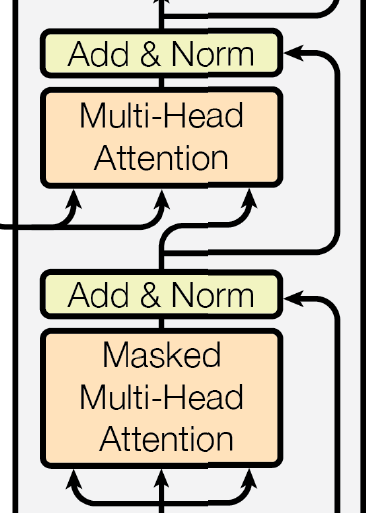Transformer中数据维度的变化和mask
会用到的一些函数
nn.Embedding()和padding_idx
a = torch.LongTensor([0,1,2,3,4])
emb = nn.Embedding(10,5,padding_idx=0)
emb(a)
## output:
# tensor([[ 0.0000, 0.0000, 0.0000, 0.0000, 0.0000],
# [ 1.2378, 0.2666, 0.3143, -0.4785, -0.0261],
# [ 0.9385, 1.8889, -2.1237, 0.9485, -0.5656],
# [-0.6171, 0.3276, -0.5347, 0.1167, -0.7167],
# [-0.5722, 1.7916, -2.8614, 0.1669, 1.2874]],
# grad_fn=)
在这个句子中,0是padding_idx=0时,这里不做embedding处理。
unsqueeze(1) 增加维度
a = torch.LongTensor([1,2,3])
print(a.shape)
a = a.unsqueeze(1)
print(a.shape)
# torch.Size([3])
# torch.Size([3, 1])
np.triu创建一个上三角矩阵,右上角为1,左下角为0
print(np.triu(np.ones((1, 8, 8)), k=1).astype('uint8'))
# k=1即从第二列(索引为1)开始;
# [[[0 1 1 1 1 1 1 1]
# [0 0 1 1 1 1 1 1]
# [0 0 0 1 1 1 1 1]
# [0 0 0 0 1 1 1 1]
# [0 0 0 0 0 1 1 1]
# [0 0 0 0 0 0 1 1]
# [0 0 0 0 0 0 0 1]
# [0 0 0 0 0 0 0 0]]]
在torch.Tensor中查找某个特定值的所有位置
value = 1
print((test_tensor==1).nonzero())
masked_fill用法
a = torch.LongTensor([[1,2,3],[4,5,6]])
masking = torch.LongTensor([[1,1,1],[0,0,0]])
masking = (masking==0) #get the booling value, if equal to 0, then set it to True
a.masked_fill(masking,value=8)
# tensor([[1, 2, 3],
# [8, 8, 8]])
Layernorm

a = torch.rand((2,50,1,64))
###layernorm的形状即是输入张量的除第一位以外的形状
layer_norm = nn.LayerNorm(a.size()[1:],eps=1e-6)
layer_norm(a)

torch.eq
>>> torch.eq(torch.tensor([[1, 2], [3, 4]]), torch.tensor([[1, 1], [4, 4]]))
tensor([[ True, False],
[False, True]])
Encoder
Input: batch of sentences with max length = 50
embedding_layer + positional_embedding
[batch_size,max_len,1,embed_size]
在词向量层中,我们需要把Multi-head attention之前,我们可以直接在词向量层中将其设置为0;
Encoder block(xN stacks)
Input size: [batch_size,max_length,1,embed_size]
Multi-head attention
将输入的输入做了上述操作之后,得到Q,K,V三个矩阵,在进行softmax()之前,由于我们不希望看到masked_fill,将所有原-inf. 这样softmax()对应的结果就会是0.
接下来详细说明Multi_head中的维度变化:
假设我们一共有num_heads个head, 每个单词对应词向量的大小为embed_size。由于我们希望做了attention之后的输出,维度与输入相同,所以我们把head_size设置为head_size=embed_size\\num_heads,且embed_size % num_heads==0。
因此, W Q , W K , W V W^Q,W^K,W^V WQ,WK,WV 三个矩阵的维度为:
[embed_size, num_heads*head_size],这里可以理解为把多个头的结果concatenate起来。
将Input分别于这三个矩阵相乘以后,得到的Q,K,V的维度为:
[batch_size,max_length,1,embed_size(num_heads*head_size)]
接下来对Q,K,V进行维度上的变化。
在上面的操作中,Q,K,V可以看做是每个输入经过8个attention head,每个head的size是8,(8*8=64=embed_size)。我们需要将每个head得到的结果分开,然后在每个head中进行softmax的操作。于是有:
K = K.view(batch_size,-1,num_heads,head_size)
##转置
K = K.transpose(1,2)
## K.shape=[batch_size,num_heads,max_length,head_size] 完美!
参考以下这张图:
我们可以理解为,对于同一个句子,我们用num_heads个头去看他,又由于head_size=embed_size\\num_heads,所以会得到这个形状的张量。
softmax()
s o f t m a x ( Q ⋅ K T d i m K ) softmax(\frac{Q·K^T}{\sqrt{dim_K}}) softmax(dimKQ⋅KT)
这里还要对K进行一次转置,转置后的结果为:[batch_size, num_heads, head_size, max_length]
Q与K的转置相乘后的结果为:[batch_size, num_heads, max_length, max_length]
这时,我们需要对矩阵进行mask操作;之后我们可以进行softmax。
对 Q ⋅ K T Q·K^T Q⋅KT的结果进行mask
首先,我们可以确定,我们不希望模型看到-inf,然后softmax得到的结果为0。
对pad进行mask
也存在padding的位置,在进行一个Multi-Head Attention计算后,就使得原来是0的位置不是0,所以attention输出的这些位置也应该为空,所以只需要在attention计算之后把相应的位置替换为0即可
如何对数据进行mask操作
pad mask
test = embed(test_src) # [2, 50, 1, 64]
mask_row = int((test==0).nonzero()[:,0][0]) #mask from this row
# score shape [8,50,50]
mask_1 = torch.ones((8,mask_row+1,50))
mask_2 = torch.zeros((8,MAX_LENGTH-mask_row-1,50))
mask = torch.cat((mask_1,mask_2),dim=1)
mask = (mask==0)
##
a = torch.rand((8,50,50))
a = a.masked_fill(mask,value=0)
Decoder
基本操作与Encoder相同。**不同之处在于,训练时Decoder可以并行;即:在Decoder中输入整个target句子,在做maked self-attention时,我们把将来的信息Mask掉。**得到的矩阵经过self-attention,在这一层注意把
Encoder的output,作为decoder中self-attention的K和V,我们不需要对其进行padding mask,我们只对Q进行padding mask,Q是target转化而来的。

Decoder中Masked Multi-Head Attention中的Mask(第一个attention)
其次我们需要注意的是,在decoder训练过程中,输入可以是一个完整的句子,我们设置一个上三角矩阵mask,即:第一行只看到一个单词,第二行看到两个,第三行看到三个…以此类推,直到最后一行才能看到整个完整的句子。
例如我们得到如下的一个masked multi-head attention的输出:
[外链图片转存失败,源站可能有防盗链机制,建议将图片保存下来直接上传(img-vI8wnxOg-1610524746734)(https://i.loli.net/2021/01/08/VtTsuoLkKNdOw8C.png)]
第一行是
Multihead attention中的mask(第二个attention)
跟Encoder中的类似,对 s o f t m a x ( Q ⋅ K T d i m K ) V softmax(\frac{Q·K^T}{\sqrt{dim_K}})V softmax(dimKQ⋅KT)V中的 Q ⋅ K T Q·K^T Q⋅KT后,对Q中原本的
Tips:
总的来看,transformer训练的时候是用ground truth来进行teacher forcing,预测的时候需要一个单词一个单词的预测。